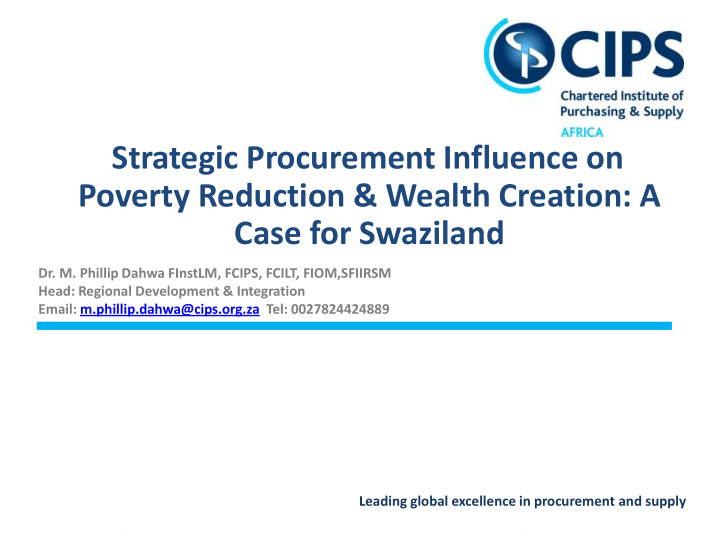



Strategic Procurement Influence on Poverty Reduction & Wealth Creation: A Case for Swaziland Dr. M. Phillip Dahwa FInstLM, FCIPS, FCILT, FIOM,SFIIRSM Head: Regional Development & Integration Email: m.phillip.dahwa@cips.org.za Tel: 0027824424889 Leading global excellence in procurement and supply
Facts about Swaziland 1. Population - 1.4 Million 2. Economy - Receive +/- 90% imports from RSA - 60% Exports through RSA - Currency pegged to the ZAR - Gvt. major funding from custom duties from Southern African Customs Union - Approx. 70% of population depend on subsistence agriculture - Sugar & wood pulp – major foreign exchange earners •
Global Economic Developments 1. 2007, sugar industry changes leading to a 17% decline in EU sugar prices 2. Customs revenues dropped due to drop in RSA imports 3. 2009 Global financial crisis implications on world economies including Swaziland major trading partner: - Republic of South Africa - European Union - USA
Domestic Issues Affecting Economic Growth 1. Weak business environment that discourage private investment 2. Weak fiscal policy that fail to prioritise public investment 3. An overvalued exchange rate that hampered exports 4. Highest HIV and AIDS rate that weakened productivity 5. Private sector (SMEs) are underdeveloped 6. Foreign Direct Investment is low 7. Historical high level of Gvt. expenditure
Implications of the Prevalent Challenges 1. In 2011, Swaziland experienced a severe fiscal crisis that set back economic and social development due to: - Sharp fall in SACU receipts; - Gvt scaled down on major infrastructure projects; - Government limited access to borrowing; 2. Risks to inflation are on the rise 3. Slowed economic growth 4. Over 50% unemployment in the 15 – 24 age group
Cont.. 5. High levels of inequality, poverty (63% of population in 2010); food insecurity (29% of population in 2010) and unemployment (29% of population in 2010). 6. Cuts in capital and social spending, undermining future growth 7. Gvt arrears of about 4% of GDP at the end of 2011, including debts to private contractors, the crisis has hurt an already struggling labour market and made things worse for small and medium enterprises (SMEs)
The Economic Recovery Strategy (ERS) In 2011 Objective is to “raise annual economic growth to 5% and create 30000 jobs by 2014” Key sources of growth: - Foreign Direct Investment - Domestic investment - Human capital - Infrastructure - Trade etc
Where do we go from here? 1. Blame the government? 2. Blame foreign investors?? 3. Blame the leadership??? 4. Not a problem for procurement professionals???? 5. Just wait and see what happens next come 2014????? 6. I don’t know?????? “Together We Can Help Improve The Situation”
Procurement Primary Objectives To acquire goods, services and works competitively through contractual arrangement by the public sector: • At the right price • From the right source • At the right specification that meets users needs • In the right quantity • For delivery at the right time • To the right internal customer
Objectives of Strategic Procurement • Supports socio-economic objectives of achieving poverty reduction and creation of wealth: - Facilitating the use of public sector for public ends - Efficient utilisation of resources or fiscal discipline - Better value for money – goods, services and works - Support the development of particular marginalised industry, SMEs, groups and regions
A Case For Swaziland SMEs • Local, regional and international supply market development factors to consider. Africa’s perceptions “foreign good local bad” effects on: - Wealth creation - Export market - Job creation - Poverty reduction - Sustainable development
Challenges Faced by SMEs In Africa • High cost of doing business / too bureaucratic • Statutory / administrative discrimination • Unequal treatment / distortions in the competitive business environment • Fraud and Corruption • Lack of capacity in the area of procurement • Changing business environment • Public and Private sector partnerships
Cont... Public and private procurement practices of patronage and favouritism when awarding contracts. Critical Success factor: • Commitment to professionalization of public procurement • Grow local talent in technical and leadership competence • Deliberate attempt to close culture gap between public & private sectors
People Development Grow local procurement talent and capability Leadership ‘Self -awareness to self- responsibility’ Technical ‘Quest for technical excellence’
Conclusion • Efficient and effective private and public procurement practices can therefore contribute to national development. • Public procurement is the largest spending process for governments and can influence socio-economic development • Leadership / Political will to promote people development in procurement technical and leadership competences • Together we can!
Thank You! ?
Recommend
More recommend